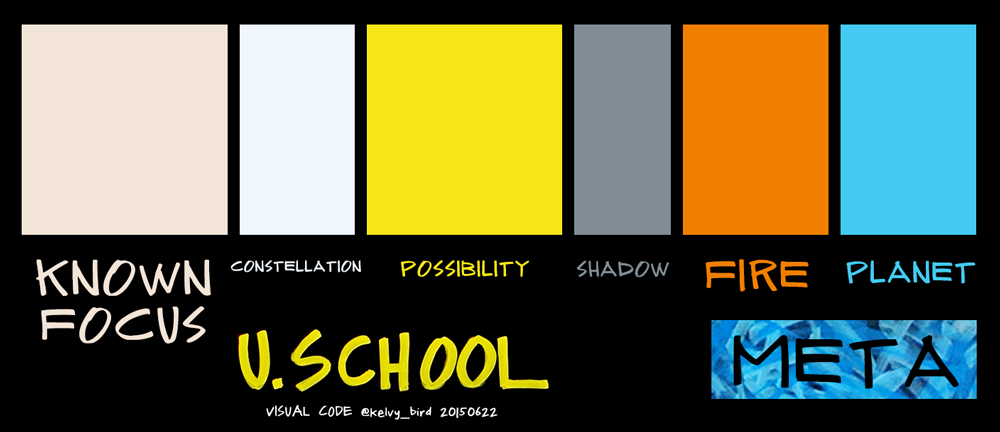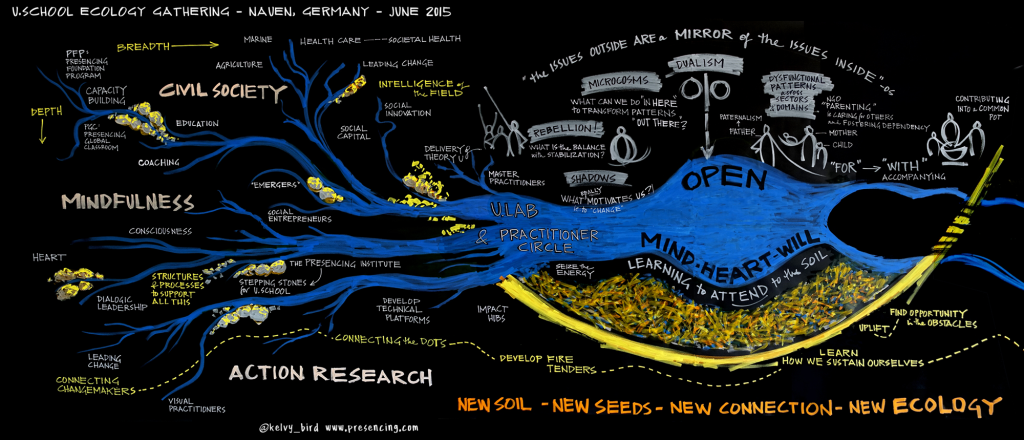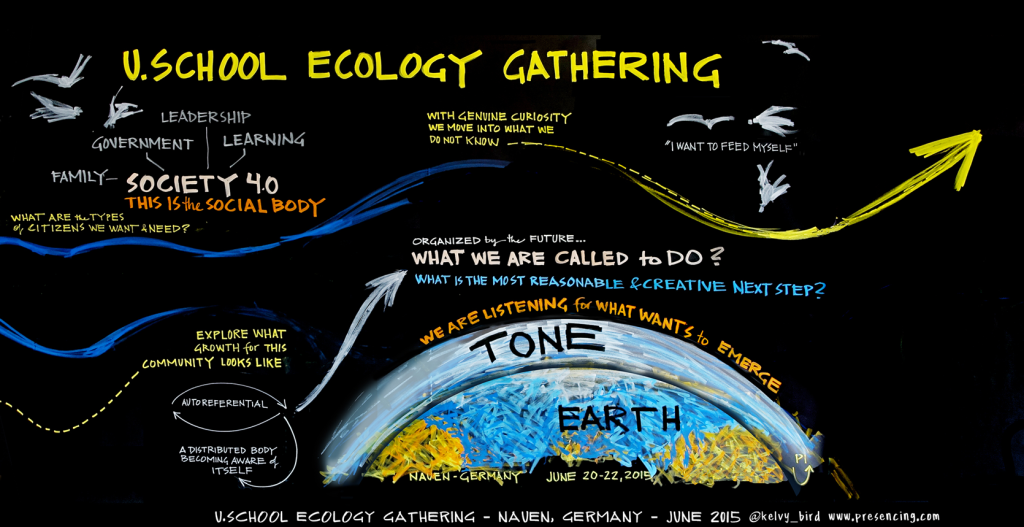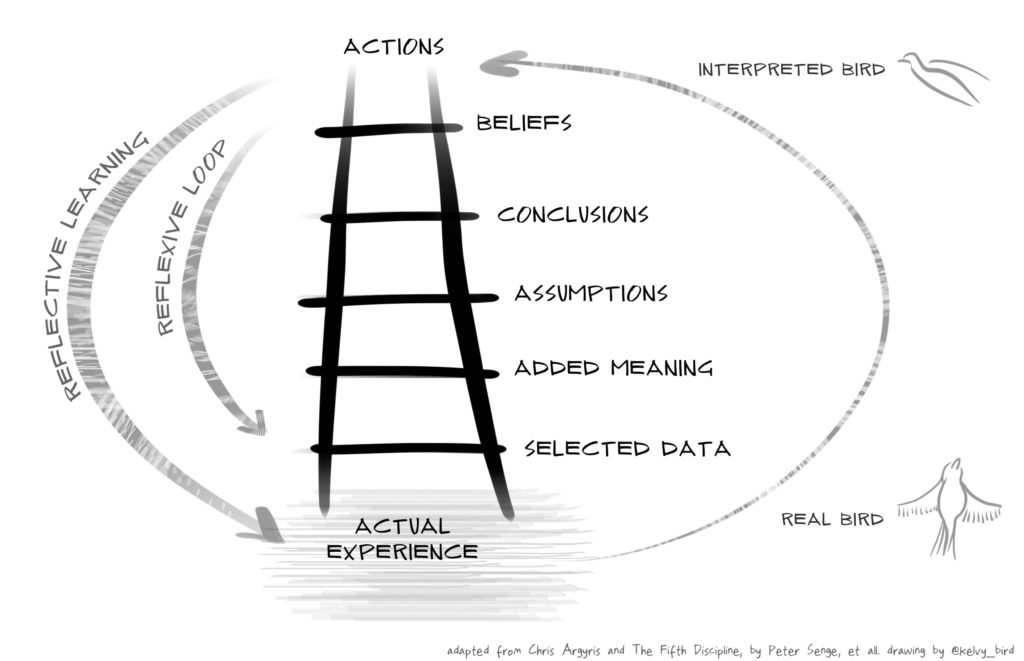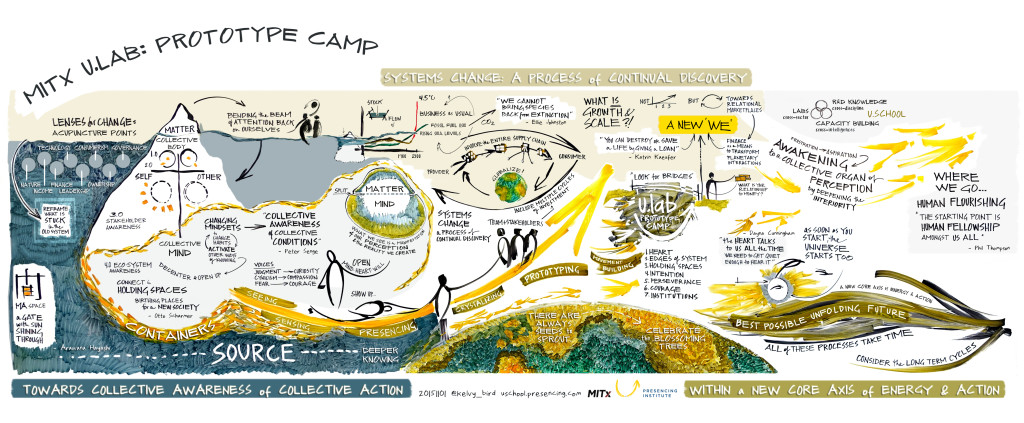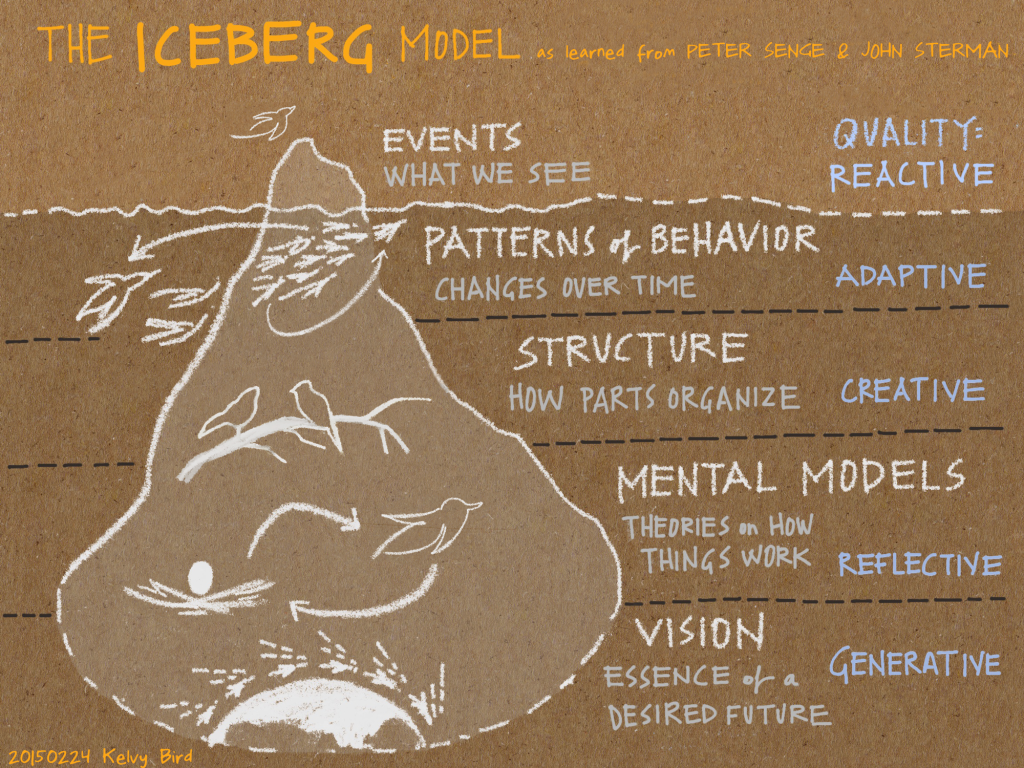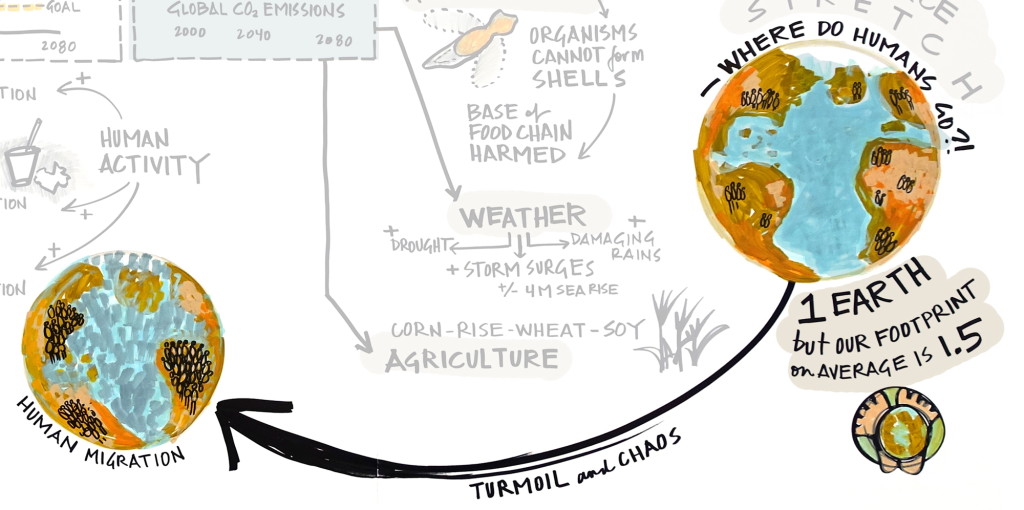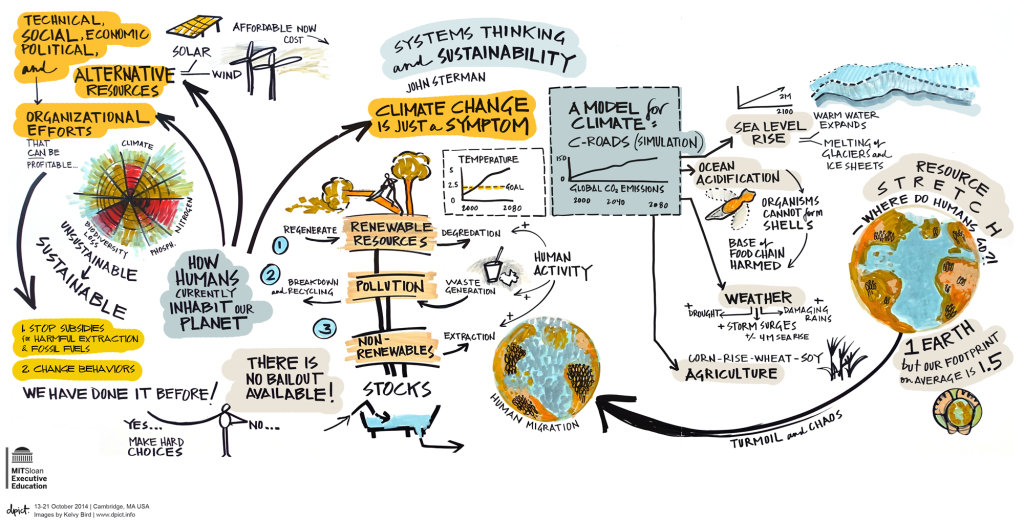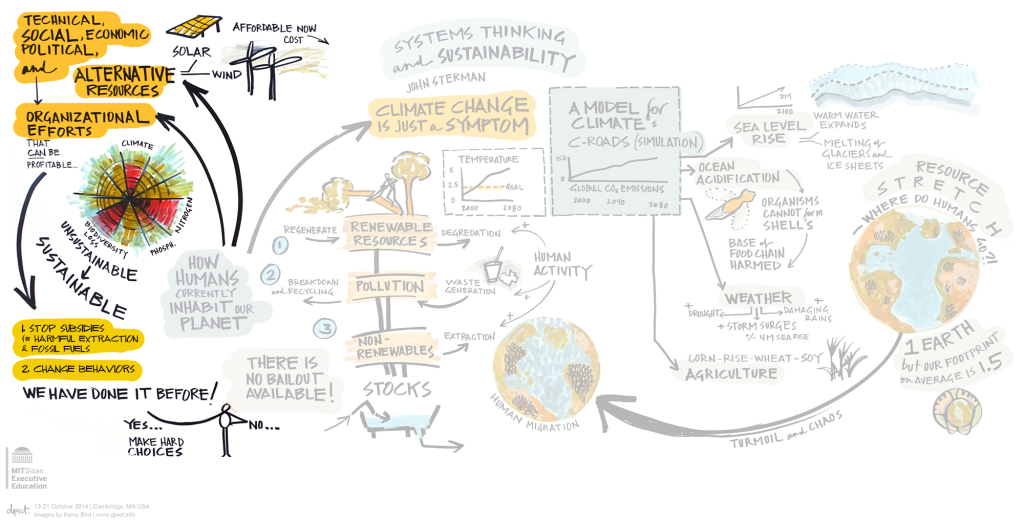This is a long post, with the following headlines (and i fully support skipping ahead):
GROUNDING – JOINING – HOLDING – CREATING – LETTING – CODING – REFLECTING
In the spirit of decoding, will attempt to articulate my approach to system seeing and scribing, focusing on the making of the ~20 foot long wall that came to life during the U.School Ecology Gathering in Nauen, Germany in June 2015. Here is a final image (here for Chinese!) and in the writing that follows – the background, thinking and intuitive process along the way.
Italics represent the inner voice…
GROUNDING
The first step, in the months leading up to the session, was ensuring we had a long wall onto which the venue would let us tape paper. No wall, no drawing. The team agreed on a black background, to reinforce the previous U.Lab images, therefore to reinforce the existing visual pattern. Angela Baldini – who organized the set up with tremendous care and attention to detail – provided a two-step stool for high reaching, power stick-on strips, and paper. I brought along a small bag of Montana acrylic / Pentel chalk markers and a roll of tape. Simple.

After traveling overnight from Boston, I arrived early to Landgut A. Borsig to adjust and start sensing into the PLACE. Nourished. Slept. Walked in the woods around the lake. The value and transformative impact of a natural setting – immeasurable. There is no greater rebalancer than earth.

In the gathering room, at the time to get tangible, the inner voice rang: Span as wide as possible… Aim for a wrap… Aim for a surround… Prepare… Expand like the lake. Rise like the trees. Sing like the birds. Claim the path like the slow-moving slug. (Yes!)

I calculated the widest possible range and put paper in place, and was nervous, as usual. Can i deliver? I am sure, and never quite sure. The ego was large; the selfless self, not yet online.
As a seed microcosm for the coming 2 days, our team reviewed the design, and the ‘weaving streams’ theme appeared as we named the many flows and directions about to converge. I sketched it loosely, to block the real estate, and to test the feasiblity of a river metaphor as a visual underpinning. It was enough to have in mind, and also was not something to cling to – a helpful image, at best. Just a scribble.
JOINING
The bus arrived! Familiar and new faces started pouring into the room, everyone curious, excited, a bit weary, readying. Join. Meet. Greet. Hug. Remember. Re—member. Get curious. Slow down inside in preparation to speed up outside. Breathe. Open. Be WITH. As the room settles, as the system in the room forms, notice. Listen. Attend to the aperture in self and others. Once there is form enough to shape – rise, ready. Only then.
The session began, and the wall spoke: “Leave me blank! Let me find my way. Let them acclimate to me, and me to them.” Let people sit and settle into the stillness of the blank black, into spaciousness... This might sounds weird – but i really do attune this way. Conversing with the wall, the paper, whatever canvas – this is part of my process. It’s sensing into the surface for what wants to be drawn onto the surface. It’s as about much joining the 2-dimensional plane as it is about joining anything else.
HOLDING
Find a way into the container to help stabilize it, reinforce it, and expand it. We are reflective aids. We are in that particular place, at that specific moment, to make visible what a room of people hear and feel, framing and organizing with utmost respect to what is trying to come THROUGH. Before anything, find a place in the circle.
To reflect the system, one must see the system. To see the system, one must perceive the moves being made by the people and intuit the currency of energy between the moves. Feel into the pauses, the gaps, the silence. Our marks reinforce the safe structure the system requires to in turn open, soften, see.
Draw with crystal clear intention, each mark like a twig or piece of cotton in a nest. Minimize gesture that is not necessary for the structure, as that is a waste of effort. All gestures add to a construction, with care.
Always put the container first. To make a mark before a mark wants to be made risks destabilizing the container. This work is in service of the people and planet. We are a tiny, tiny piece of that. Hold the largest possible picture and proportions – scale out to the broadest possible viewing/listening window. Consider the entire real estate of the paper, as if it were the night sky.
* A note on unintentional violence. This is not about direct physical or emotional violence; rather it’s a caution regarding structural violence at the container level. To impose our view or interpretation or fear or sadness or frustration or glee – WHILE WE DRAW – is the potential violence. Independent Will over the collective will is, in effect, a closing gesture, risking Absencing, the opposite of Presencing.
Scribing is a participatory art. Think before acting. There are consequences to over-stacking, to overdrawing – that the image becomes about indulging the artist’s needs to express and shifts away from the marks actually called for by the container. The 1st ‘juice’ comes from souls in the room, the 2nd from the marker, and then they dance.
Seek existing coherence. Consider the whole and represent the collective over any one part.

Picture by Daniel Contrucci
CREATING
Finally! In the opening session, Otto (Scharmer) spoke to the streams of the ‘W’ork. The sketch will land… I took journal notes because it wasn’t right yet to draw. But this provided what became the meta-frame of the wall. I am breaking this down in a possibly over-boring way, but many people ask how and why i make these unfolding, integrated kinds of pictures. So here we have it:
1. Three streams coming together over 10 years: Civil Society. Mindfulness. Action Research.
2. The Presencing Institute provided the stepping stones for U.School
3. PI Master Practitioners and then U.Lab as additional streams of the movement
4. Organized by the future
5. Increasing ”Forces of Absencing” regarding, in part, the recent South Carolina shooting
6. Also our time of New Soil… New Seeds…New Connection… New Ecology
We then each added our ‘stream’, one after the other. I tracked it, still on a page. The group shifted into a marketplace, with rotating breakout areas, which we documented via participant-generated post-its, versus a verbal harvest.
The mind planned. The heart, opened. The will, stretched to warm the neck, shoulder, arm & hands, preparing for that fine-threaded moment of calling. And that is when I started drawing large; i started amidst a buzz, with no one actively watching.
7. Jagged U: I drew out the above framing, and wove in a chunky brushstroke U very much on purpose, with no arrow, rough – many smaller strokes finding a way upward – no clear ending. (The U always has meaning! How it comes out of the hand speaks volumes to the entire tone of the wall. Way more than just a curve…) And that was it for the night.
Sense – Draw – Rest – Reflect. Over and over, quick cycles. Adjust pace. Condense and spread with the movement of the group. Be willing to stop – let the work breathe – give the people time to absorb the system. Leave space. Generate space. Reflection requires space.
On the morning of Day Two, Otto ran a journaling practice, guided by the following paraphrased questions:
1. When was the 1st time you connected to Presencing, and what possibility do you remember feeling in that moment?
2. Co-Sensing: Looking at the PI ecosystem, 10 years back to now, what is emerging?
3. When you die there is a gift: What are some recent moments of failure? What is dying? What is being born?
4. Looking 10 years forward, what future of the ecosystem, of society, of self do I see?
5. End-of-life: What do I want to leave behind? What footprint?
6. Kids of our kids: How would they advise us?
7. What is the highest potential for U.School?
8. What prototypes, 3 to 6 months?
9. What is the minimal organizing infrastructure to put in place?
10. Who are the key people I/we need to connect with?
Then folks went on a paired dialogue walk, returned for a break and small sharing clusters, and then in a reformed circle, voiced the following, which I’ve numbered to continue the decoded build of the wall. It was the first wave of synthesis.
8. Shadows: The room blossomed into a rich sharing of what i (and others) interpreted as an uprising of the shadow. Otto earlier had said, “The issues outside are a mirror of the issues inside,” and this seemed like a perfect segue. Added the upper arc into area (5) which i’d instinctively preserved the night before, when there was absolutely no way I could have logically predicted this coming conversation. The content was on no agenda; it was entirely spontaneous.
* In hindsight, there is something to still seek here… looking at the image now, the shadow is the section that appears to glow – and the ‘light’ of the conversation seems visually darker. In part, this was the lighting in the room. In part… The shadow, almost closer to the surface; the luminosity, found inside, underneath. (‘Gathering’ radiates brightly too…) Even if not crafted in this way, then, i see it NOW and am led to wonder.
9. Open Mind-Heart-Will: Brought up as a kind of transformative passageway, where dualism relaxes into oneness. I had anticipated this placement, but not the timing. I had been considering this section of the drawing as the delta, where river meets the ocean, where freshwater merges with salt, a tidal area rich with coastal life, dependent on a very balanced blending of these types of waters. This to me exactly represents the territory of Presencing being met in the world.
10. The Three Voices, which i took out the next day because they had not actually been spoken in the room – I had put them in, then realized the possible interpretive imposition.
11. Window of opportunity that could be closing and any moment. I had it in, then next day took it out, seeming to come from some of the group, but just some. Over and over with this wall, I kept wanting to HONOR the VOID, which seemed much more interesting and evocative to reinforce as a visual negative space, than it would have been to label as a window or opening. It was drawn and named, therefore, by the absence of words – like the remaining open area in the 2012 Master Class drawing. The hidden link to another void… (the white space on the right, the egg-ish area.)
12. Arc of the Earth: Having that other picture in mind, the next day at some point when I was led to include Earth, I sought to echo the gestures of that other wall – the U on the far left, and the “Find Golden Moments” curve under Being. I was liking the subtle relation between walls that only i would like ever know (until now.) And it made sense, as the 2012 session was in nearby Berlin, and created out of very deep territory – as was this wall from Nauen.
13. Society 4.0 was fleshing out, still mostly a placeholder.
14. Field: After dinner on day two, i was exhausted and could no longer keep conversation at the late European-style 9:00PM dinner. What?! AND… something compelled me back into the main room, in silence, alone, to lend an eye with distance. I went and sat for a while in the empty circle – sat with the kind of peace I used to sit with when painting – seeking guidance from what was already expressed and for what was seeking expression. Leave space. Leave full yet empty forms. It did not seem like there was enough width either, though there was a lot. I added another meter of paper to the right.
And the zone between the bottom of the U and the delta… Antoinette Klatsky, in an earlier side comment, confirmed it was something. We didn’t know what. Sitting there alone, i realized it was the field and absolutely could not clutter it up with words. In her honor, i brought in a very hidden reference to a painting from 2009 that seemed a perfect fill, not needing naming, the underbelly:
LETTING
At this point, overnight, ‘flow’ had arrived. Thank goodness. I always trust it will come, but it’s never something to claim; it comes when ready, when the container is formed and fertile. And HERE is where the act of drawing loses it’s literal progression and takes on a life of it’s own. A surrender happens – seriously! – to the materials, the form, the inner knowing, Klänge. The mind and heart, well-pumping; the work – sustaining that pumping, more than anything else. The will, the hand, easily follows; it’s a merely a faucet, on.
15. River: The shape seemed to have morphed into a fish – the field belly – the organs blue. The “open mind heart will” words had been occupying what wanted to be a shape – not merely a list within a shape, but instead a pregnant shape, swollen, as if the area of heart-mind-will wanted to be THE transformative place of the entire picture, mysterious, touchable. That place then reached forward with two arms out, into the black void, to wrap around the possibility inside that void and support Society 4.0. Those arms were everything. (Looking at the drawing now, my favorite lines of the entire piece are those blue arms, tentacles to the future.)
The dialogue in the morning was a surprise for which I was unprepared; it had been planned as a 15 to 20 minute pop-up check in that I could track in my journal, to conserve the wall. When it clearly shifted into a dialogue after about only 3 or 4 comments, I was stuck in my chair due to the set up. Leaving a gap in the circle – and also the possible visual distraction of my side-to-side and up-down step stool movements while drawing – would have been awkward; the container was heating up, and it needed more holding capacity inward to the center, not turned outward to the wall. I stayed, and held steady for that dialogue and the subsequent group-suggested Social Presencing Theater. The whole morning had reformed. I needed to go with the flow, quite literally. Like the blue belly, energy burst forth. Time to dive and swim. LET GO.
LET COME. Again at the wall (at break?) haiku scribing. Only the essential: Earth, Tone, “What is the most reasonable & creative next step?”, “We are listening…”, “I want to feed myself,” from the voice of the marginalized, Birds, as a tribute to the swallow-swarming venue, and then the Auto-referential loop balanced by “A distributed body, becoming aware of itself.” That was it from about three hours of content.
16. Curiosity… in the end, the arrow does not complete on the initial U, but finds it’s forward gesture only after passing through the void, the area collectively sensed INTO.
17. Tone… the base-note of all practice.
18. Community… becoming aware.
19. “I want to feed myself”…
speaking to the very core of things. Our planet, including all species, as it wants to be.
20. Gateway: Preserve the void – never box it in – keep it free. The golden arc was initially solid, but as the very last pass, the very last stroke, I broke the line to let the void have its own sort of dominance. The unknown needed to be stronger. In fact, if i had not cropped the image for digital distribution and printing, i would have left MORE VOID on the right. Do you see that marked out black curve? That was something, leading somewhere. That is the begining of the next piece…
The final overall gesture can be found as two main movements: the first from the three original streams through the river, through Absencing, through the Open Mind-Heart-Will, through the Field, leading to Society 4.0; the second from Society 4.0, connecting down into Earth, through a balancing loop, touching back through Tone, up to singing birds.
Nothing relocated in Photoshop editing – only cleanup of black, and reinforcement of the tone band, as that seemed a primary note that the circle spoke as wanting to include and sustain in all the work we do – to carry inside and forward.
Close – Document – Reflect – Share – Reset – Renew
CODING
I had been thinking the coding idea came on the trip home, through a frantic mass-journaling download. Yet in preparing this piece here, i realized the inspiration came much earlier. Look what was in the woods on that first walk! Beautiful, lasting guideposts of the ecosystem to be discovered:
And re: my own coding… I always attempt to assign meaning to font size, color, line, and texture – to help with my own information hierarchy, but mainly to avoid distraction. Color, especially, is a constant suitor – and I’ve learned to minimize the distraction it brings, even when looking at an array of markers, by starting simply and adding slowly, letting the code come.
PS: This is a wink to Kandinsky PPS: It does not always work out, but I try fresh, every time.
Oh, and Black = Universe….
In crafting this piece, and rereading it, I realize how very organic the process might seem. It is a kind of birthing, both in how I approach the creative process, and how it plays out. When I work with groups who share my organic sensibility, I can go farther in that direction, which allows my own process and the group’s appetite to fully meet.
Scribing is more than representing ideas; it is an art. It is an act of nature, like a gust of wind on the surface of a lake, slightly changing the relationship of the water and land to light for a few seconds. That’s all this is. A moment of reveal, a moment in time, a moment that passes and leaves behind only impression.
THANKING!
With tremendous thanks to the entire U.School Ecology, U.Lab, Practitioner Circle, PI Team – Julie Arts, Angela Baldini, Dayna Cunningham, Marian Goodman, Arawana Hayashi, Katrin Kaeufer, Reola Phelps, Janice Spadafore, Adam Yukelson, and especially Otto Scharmer, for his profound trusting of the field and the place of visuals within it, actively moving us all to see just a bit more clearly. And Peter Senge’s gift, accompanying me on every trip.
And… Quijia Chen, Lili Xu Brandt, and Jayce Pei Yu Lee – for this beyond stunning translation into Chinese! Click the image for an up close look…









